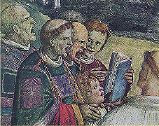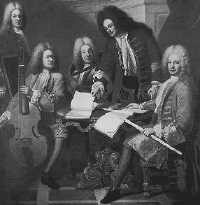Polyphony
 PODCAST
PODCAST
A musical texture featuring two or more equally prominent melodic lines played at the same time.

|
|
|
Fig 1: Baroque orchestra, Nuremburg: Ger. Nat. Mus.
|
[Example 1: Fourth Brandenburg Concerto, 3rd movement.]
Polyphony is a musical texture that features two or more equally prominent melodic lines played at the same time. Each of these lines can be thought of as a melody in its own right -- one that could be sung, played, or listened to independently of the others. But it is the combination of the different strands, all interacting together, that creates polyphony.

|
|
|
Fig 2: Four independent, simultaneous lines, forming a polyphonic texture. |
[Example 2: medieval polytextual motet EntreCopin/Je me cuidoie/Bele Ysabelos ]

|
|
Fig 3: Medieval singers
|
Polyphony may be likened to a dialogue, a discussion, or even an argument between two or more speakers, all talking concurrently.
As a result, polyphony may be judged as the most complex of all the musical textures, since it challenges a listener to concentrate on several, equally important layers of sound.
The musical lines in a polyphonic texture may be instrumental or vocal, or both. Polyphony may dominate an entire musical work, a significant section of a piece, or it may appear for only a short time.
For example, in both of the following excerpts, a section in a more active polyphonic texture is either preceded or followed by one in which the various voices and instruments play in synch with one another. The portions that do not use polyphony therefore urge the listener to concentrate on a single melody in the overall texture, rather than on the several layers of sound.
In the first of the two selections that follow, an early 19th-century sacred piece from the United States, the opening two lines of the text are sung together -- at the same time and to the same rhythm -- by all the parts. Beginning with the words "Fly swift around ye wheels of time," however, the various vocal components go their separate ways, creating polyphony, and then come together again for the closing line. These changes in texture not only illustrate the use of polyphony for musical contrast, but also effectively depict the sense of the text with its emphasis on flight and its invocation of the churning wheels of time:
[Example 3: American fuguing tune Northfield ("How long dear Saviour, O how long")]
| How long, dear Saviour, O how long | |
| Shall this bright hour delay? | |
| Fly swift around ye wheels of time, | |
| And bring the promised day. |

|
|
Fig 4: Beethoven
|
In the next excerpt, from Beethoven's Ninth Symphony, a busy musical phrase winds its way throughout the orchestra. This little tune first appears by itself immediately after the opening orchestral thunderclaps, and gathers momentum as it travels from top to bottom. Finally, after creating incredible tension, the texture changes to what we call homophony, as we hear the melody again triumphantly on top, but with the other members of the orchestra in a supporting role.
[Example 4: Beethoven: Ninth Symphony Scherzo (opening)]

|
|
Fig 5: Trio sonata: gamba, two flutes
|
In addition to alternating with other textures, two or more polyphonic lines may combine with other melodies or with a supporting accompaniment. The presence of these accompanying parts does not challenge the overall description of the section or work as polyphonic.
In the first of the two following examples--this one from a Baroque trio sonata--two violins interweave a polyphonic musical dialogue over the support of a bass line with harpsichord accompaniment.
[Example 5: Giovanni Legrenzi, Trio Sonata: La Rasponsa (1665), first movement]
In the second example, from a composition written in 1981 by Steve Reich, two echoing women's voices and an equally prominent percussion ensemble vie for attention over a series of sustained chords provided by accompanying strings. The text here is taken from the Hebrew Psalms.
[Example 6: Steve Reich, Tehillim, movement 1]
| Ha-sha-my´-im meh-sa-peh-rím ka-vóhd Káil, | The heavens declare the glory of G-d, | |
| U-mah-ah-sáy ya-díve mah-gíd ha-ra-kí-ah. | the sky tells of His handiwork. | |
| Yóm-le-yóm ya-bée-ah óh-mer, | Day to day pours forth speech, | |
| Va-ly´-la le-ly´-la ya-chah-véy dá-aht. | night to night reveals knowledge. | |
| Ain-óh-mer va-áin deh-va-rím, | Without speech and without words, | |
| Beh-lí nish-máh ko-láhm. | Nevertheless their voice is heard. | |
| Beh-kawl-ha-áh-retz ya-tzáh ka-váhm, | Their sound goes out through all the earth, | |
| U-vik-tzáy tay-váil me-lay-hém. | and their words to the ends of the world. |
Summary:
- In short, Polyphony is a musical texture that features two or more melodic lines played at the same time. Each of these melodies is essentially equal in prominence and musical interest.
- The musical lines in a polyphonic texture may be instrumental or vocal, or both.
- Polyphony may dominate an entire musical work, a significant section of a piece, or may appear for only a short time within a composition.
- A polyphonic texture may be accompanied by other melodies, or supported by a series of chords. These accompanying parts do not challenge the overall description of the section or work as polyphonic.
|
Polyphony written by: Thomas Payne
Recording & Mixing: Bradford Garton, Terry Pender Narration: Thomas Payne Producers: Ian Bent, Maurice Matiz |
